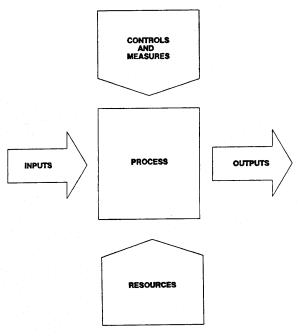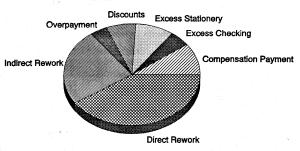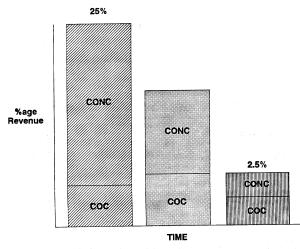Pkg Solutions
Quality Glossary
Cost of Quality
Quality costing is a Powerful technique to monitor the 'real' effect
to the business of failing to achieve requirements. When a requirement
is not achieved ' right first time' the full cost impact is attributed
to the non conformance.
Non conformances are measured in Vs not number, percentage etc. as this
enables effective prioritization
and justification for corrective action.
Our experience has shown that rework involving over 20 products could
be focused to 2 because these carded almost 80% of the cost of rework.
Our experience has also demonstrated that there is no Economic Quality
Level and that ft is always cheaper to 'get it right first time'. Two
measures of Cost of Quality are monitored:
1. Cost of Conformance (COC)
This is the money invested in prevention to ensure that requirements
are met first time.
2. Cost of Non Conformance (CONC)
This is the cost of failing to 'get it right first time'.
THE SIZE OF THE PROBLEM
Experience has shown that a typical manufacturing organization wastes
between 20 25% of its total revenue, and that a service organization can
waste up to 40%. Careful corrective action, investing in COC, can lead
to dramatic reductions.
One myth is that Quality Costing applies only to the product, i.e. the
item which the customer sees. This is only part of the story. Quality
Costing applies to every activity within the organization. Every activity
that is not performed right first time, creates quality costs in being
corrected.
For example, poorly organized meetings, manager's progressing other
people and unanswered telephone calls.
These costs multiply the effect in CONC where several processes link
together, so that a mistake in an early process will require much larger
costs in order to rectify later. For example, a clerical mistake on a
customer quotation at receipt to the company, could be rectified quite
cheaply if picked up immediately. However if the mistake is processed,
this will involve more departments, people and systems in work that will
all need re doing. The costs escalate quite dramatically.
The above are examples of the actual costs. In addition, there are lost
opportunity costs. For example, how much business was lost due to errors,
the slow responses, the poor image presented? These costs are difficult
to quantify but are known to exist.
An acceptable approach is to be aware of them, but not to try and evaluate
them. Rather, to spend the effort on removing every visible mistake, every
non conformance. If these are removed, the lost opportunity is automatically
reduced. The approach is to focus on the visible, the tangible.
COST OF QUALITY METHOD
1 . Data Collection
This Identifies the key cost measures for the business. This will be
achieved by educating a team and developing a pilot approach. Once agreed
as acceptable, the approach will be repeated for the entire company. At
the end of this phase the Cost of Quality will have been determined.
This first cost model will probably not identify all of the costs. This
is because the understanding and identification of conformances and non
conformances requires education and realization from the entire workforce.
This will occur in due course via awareness cascading and support from
management. No one readily admits to non-conformances until they feel
the culture is correct!
2. Analysis
Modem quality tools and techniques are used with the Top Team to identify
root causes from the Cost of Quality analysis. Root causes will be identified
enabling Problem Solving Teams to be set up to follow through the Improvement
Process.
3. Problem Solving Teams
Prioritized Teams are set up, trained and supported in reducing identified
problems.
SUMMARY
The Cost of Non Conformance is the cost incurred
when we fail to 'get it right first time'.
The Cost of Conformance is the cost invested in
ensuring that we get it 'right first time'.
The Cost of Non Conformance is typically 25% -
40% of a company's revenue.
Key company problems can be identified and prioritized
through Cost of Quality analysis.
Correctly focused Problem Solving Teams can increase
profitability by reducing the Cost of Non Conformance.

DEFINITION - Cost of Non Conformance (CONC)
The cost incurred by failing to achieve an activity right first time
on time every time
DEFINITION - Cost of Conformance (COC)
The cost of investing to ensure activities are achieved right first
time and problems prevented
COST OF QUALITY =
THE SUM OF CONC AND COC
Cost of non conformance
Example:
Creating Proposal
COO within Process
COQ
Downstream
Hit rate
Under funding
Late delivery
Concessions

